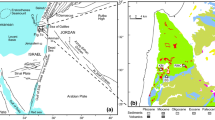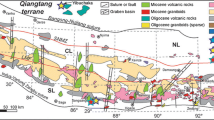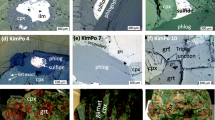Abstract.
Lower crustal granulite xenoliths have been found in Pliocene basaltic tuffs at two newly discovered localities in the western Pannonian Basin. Most of them are mafic meta-igneous rocks, among which garnet-rich lithologies are common. In general, clinopyroxene, garnet and plagioclase, with minor ilmenite and scapolite dominate their mineralogy. Several are amphibole-bearing, which is interpreted as evidence for a recent metasomatic event in the lower crust beneath the Pannonian Basin. Meta-sedimentary granulite xenoliths have also been identified in the region for the first time. Their mineralogy is characterised by the absence of clinopyroxene combined with a high proportion of Al-rich phases, especially plagioclase and garnet together with subordinate spinel, sphene, rutile, orthopyroxene and quartz. One sample contains biotite and several contain graphite. Thermobarometric results indicate temperatures and pressures of 800–950 °C and 8–15 kbar for all xenolith types, considerably higher than for most granulite xenoliths from other regions of Phanerozoic Europe. Given that the Pannonian Basin is currently underlain by thin crust (25–30 km thick), the pressure estimates indicate that the crust must have been considerably thicker (40–50 km) prior to the Tertiary collapse in the region. The higher pressures recorded for the meta-igneous xenoliths thus suggest that they formed at (or before) a time when the crust was thicker, i.e. pre-Tertiary. A composite meta-igneous/meta-sedimentary xenolith provides direct evidence for interaction between sediments (or metasediments) and the magmas that gave rise to the meta-igneous granulites, indicating that the metasediments are at least as old as the meta-igneous granulites. The protoliths of the meta-igneous xenoliths had primitive mafic to slightly evolved tholeiitic liquid compositions. They are dominated by LREE-depleted compositions that resemble those of mid-ocean ridge basalts. Such compositions are rare in lower crustal xenolith suites. They are also very low in large ion lithophile elements such as K and Rb, but relatively enriched in Ba and Pb. A few slightly LREE-enriched meta-igneous xenoliths are also K and Rb depleted. In contrast, the meta-sedimentary granulites are strongly LREE enriched, but have very variable LILE contents. One possible explanation for the unusual compositions is a process of subduction–accretion of oceanic crust beneath the continental crust, rather than basaltic underplating.
Similar content being viewed by others
Author information
Authors and Affiliations
Additional information
Electronic Publication
Rights and permissions
About this article
Cite this article
Embey-Isztin, A., Downes, H., Kempton, P.D. et al. Lower crustal granulite xenoliths from the Pannonian Basin, Hungary. Part 1: mineral chemistry, thermobarometry and petrology. Contrib Mineral Petrol 144, 652–670 (2003). https://doi.org/10.1007/s00410-002-0421-2
Received:
Accepted:
Issue Date:
DOI: https://doi.org/10.1007/s00410-002-0421-2




